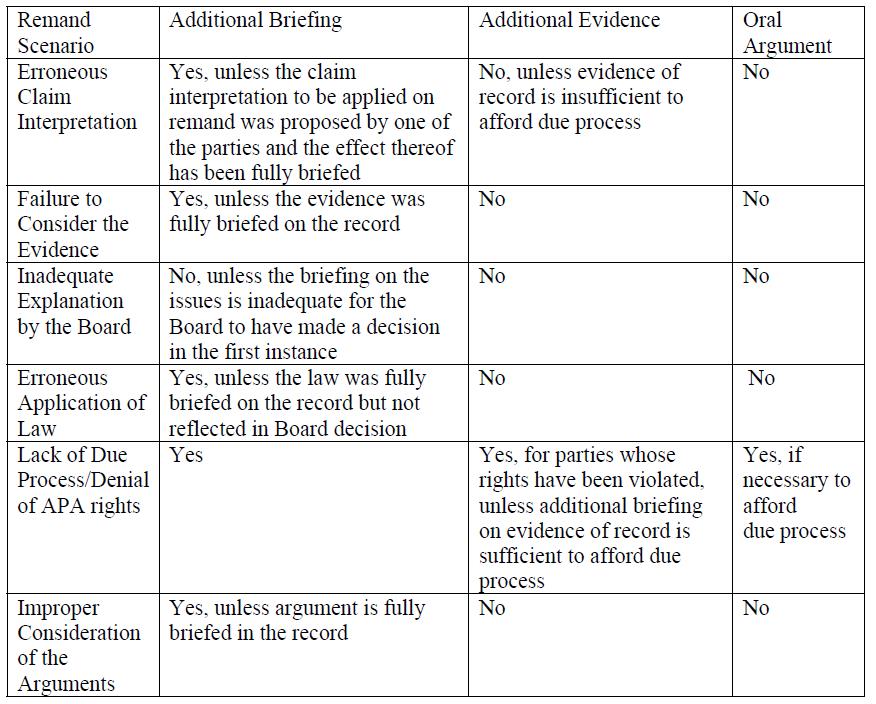On November 15, 2017, the Patent Trial and Appeal Board (PTAB) published a revised Standard Operating Procedure 9 (“SOP 9”) to provide guidance on the PTAB’s procedures for handling cases that have been remanded from the U.S. Court of Appeals for the Federal Circuit. SOP 9 “creates internal norms for the administration of the Board to promote consistency,” and “provides guidance to the parties, the public, and the Board” regarding decisions on remand. However, the PTAB emphasized that SOP 9 “does not create any legally enforceable rights.”
Due to the popularity of AIA trials including inter partes review (IPR), post-grant review (PGR) and covered business method (CBM) review, appeals from final decisions of the PTAB have surpassed appeals from district court trials involving patent disputes. The Federal Circuit also hears appeals from final decisions of the PTAB relating to ex parte prosecution and reexamination proceedings.
Timeline for Issuing Decisions on Remand
The PTAB explained that it “has established a goal to issue decisions on remanded cases within six months of the Board’s receipt of the Federal Circuit’s mandate.” The PTAB resumes jurisdiction over a remanded case on the date the mandate issues from the Federal Circuit.
Meetings with Senior Judges
SOP 9 explains that the panel of judges who issued the remanded decision must request a meeting with the Chief Judge and the Deputy Chief Judge, or their delegates (i.e., one of the Vice Chief Judges) within thirty days of receiving notice of the Federal Circuit’s decision. The panel and senior judges will “discuss the issues presented by the Federal Circuit’s decision, as well as the expected procedure for preparing a remand decision.”
Appendix 1 of SOP 9 provides guidance to panels on remand meetings. For example, Appendix 1 indicates that panels should be expected to discuss proposed procedures for remanded cases, “including whether the panel anticipates additional briefing from the parties, an additional oral hearing, and/or reopening the record to permit introduction of additional evidence.”
SOP 9 also indicates that the Chief Judge may “elect to expand the panel assigned to the remanded case in accordance with SOP 1.” However, panel expansion is expected to be a “rare occurrence” on remand.
Responsibilities of Parties Involved in Remand Decision
Appendix 2 of SOP 9 “provides guidance to the parties on procedural issues.” Parties in remanded trial cases are instructed to “contact the Board within ten (10) business days after the mandate issues to arrange a teleconference with the panel.” The teleconference with the panel is expected to occur “within the first month after the mandate.”
Before contacting the Board, the parties are instructed to “meet and confer in a reasonable and good faith attempt to propose a procedure on remand.” The parties are encouraged to reach agreement, if possible, on the following remand procedures:
1. whether additional briefing is necessary;
2. subject matter limitations on briefing;
3. length of briefing;
4. whether the parties should file briefs concurrently or sequentially;
5. if briefs are filed sequentially, which party should open the briefing;
6. whether a second brief from either party should be permitted;
7. the briefing schedule;
8. whether either party should be permitted to supplement the evidentiary record;
9. limitations, if any, on the type of additional evidence to be submitted;
10. the schedule for submitting additional evidence, if any; and
11. any other relevant procedural issues.
Appendix 2 of SOP 9 indicates that the panel will ultimately decide the procedures to be followed on remand, such as whether to permit additional briefing and/or evidence, or whether an additional hearing should be held on remand. In deciding the remand procedures, the panel is instructed to consider the scope of the remand as well as “the effect…on the economy, the integrity of the patent system, the efficient administration of the Office, and the ability of the Office to timely complete proceedings” (quoting 35 U.S.C. §§ 316(b), 326(b)). In addition, the panel is instructed to consider “the time and expense involved that permitting additional briefing and new evidence will add to the proceeding,” in view of the overarching policy in 37 C.F.R. § 42.1(b), which provides that the PTAB shall construe the rules for AIA trial proceedings “to secure the just, speedy, and inexpensive resolution of every proceeding.”
Default Trial Procedures for Common Remand Scenarios
Appendix 2 of SOP 9 contains the following chart which illustrates “the likelihood of the Board permitting additional briefing, evidence, or oral argument for various types of issues addressed on remand.” In general, additional briefing, evidence or oral argument will be permitted only if the issues on remand were not fully briefed in the original AIA trial, or the parties did not previously have the opportunity to fully brief the issues being considered on remand.
Prior to SOP 9, the PTAB’s approach to remands varied from panel to panel. The guidelines set forth in SOP 9 should provide more consistency and predictability in the manner in which the PTAB approaches remand procedure.
